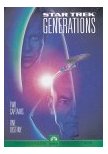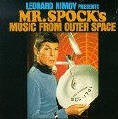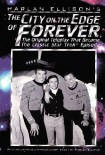
Kirk, Scotty and Chekov are on board attending the launch of the Enterprise B when the ship is forced to respond to a distress call. A couple of ships have been caught by a strange ribbon of electromagnetic energy (the nexus). For the fourth time in seven movies, the Enterprise is the only ship in position to respond to this distress call. (For the third time in seven movies, the Enterprise is still in Earth’s solar system when the call comes in. Doesn’t Starfleet keep any other ships in the neighbourhood?) The Enterprise responds and saves some of the people (including Guinan and Dr. Soran) on board the ships caught in the nexus, but an energy bolt from the nexus vaporizes a portion of the Enterprise and, presumably, Kirk along with it.
Flash forward 78 years. The Enterprise D receives a distress call from a solar research station, while Captain Picard receives some distressing personal news. His brother and nephew have been killed in a fire. Meanwhile, Data has decided it’s time to install the emotion chip that will allow him to experience emotions for the first time. The Enterprise discovers that the Romulans have wrecked the station, leaving among the few survivors, Dr. Soran. But after further investigation on the station, LaForge and Data discover that Soran has built a weapon that will destroy stars. Soran returns to the station and fires his weapon at the local star, and escapes thanks to some Klingons he has been working with.
Guinan explains to Picard about the nexus, and how she and Soran were in the nexus but plucked out just in time by the Enterprise B. The nexus is a place of joy and harmony, she says, and that everything you could want was there. Picard and Data realize that Soran is blowing up stars to alter the course of the nexus so that it hits a certain planet, where Soran will once again enter the nexus, this time permanently. Unfortunately, the next star he needs to blow up will kill hundreds of millions of people.
Picard beams down to stop Soran, while the Klingons duke it out with the Enterprise. This time, the Klingons manage to fatally injure the Enterprise before they themselves get blowed up. The Enterprise crashes on the planet. Picard cannot stop Soran who launches a rocket that blows up the sun, and alters the course of the nexus to the planet and it absorbs both Picard and Soran.
Picard finds himself having Christmas dinner with his wife and kids. Except he doesn’t have a wife and kids. He realizes this is some sort of illusion. Guinan appears, and explains that she is but a shadow of the real Guinan left behind when the Enterprise B’s transported her away. She tells Picard that he can leave and return to anytime he wishes. He wants to go back and stop Soran, and Guinan suggests there might be someone here who can help him: Kirk. Picard convinces Kirk that all in the nexus is an illusion, and together they return and defeat Soran, but at the cost of Kirk’s life. Picard returns to his all but destroyed Enterprise, and gathers a few effects, and leaves. The End.
This film has serious problems. The opening prologue on the Enterprise B is great; brisk, fast-paced and exciting. The first scenes in Picard’s timeline, involving a promotion ceremony for Worf, are also well done, but after that, with the exception on the spectacular crash sequence, the film’s pacing somehow goes off-kilter and it drags terribly in some places. The movie plays like a tv episode (I was waiting for a preview for next week’s movie at the end), and the constant alternating between an emotive scene, then a bit of action, then a bit more emotion, then some action, kills the momentum this film desperately needs. It seems to take a lot of time to get nowhere, and many things are tossed in for no apparent reason than to kill time. The Klingons, for one, could been cut and no one would have missed them.
Another major problem here is that most of the important plot points have all been done in previous Star Trek movies:
- the death of a major character;
- a madman on a deranged/spiritual quest;
- the old “give the unemotional character emotions and play him for laughs” routine;
- the old “blow up the Enterprise” routine;
- the old “kill off part of the captain’s family” routine, or, more specifically, kill off the younger generation of the captain’s family so the captain can emote and wax philosophically on the nature of life, death, blah, blah, blah;
- a strange unexplainable interstellar phenomenon causing havoc and destruction;
- and Klingons running amuck.
Data even rescues his cat, à la Alien. In addition, we’re treated to two hackneyed TNG clichés: the “alternate universe/timeline,” much overused in the last season of TNG; and Geordi shouting that’s there a warp core breach as the Enterprise begins her death throes. (Geordi saying, “Coolant leak! We have a warp core breach!” should be added to the TNG drinking game.) In fact, the Enterprise crew’s memory is slipping: Geordi doesn’t order the warp core ejected, a trick he’s done numerous times in the past; and when the Klingons discover the Enterprise’s shield frequency and blast a photon torpedo through them, no one thinks to change the shield frequency, another trick they’ve done numerous times in the past. (Of course, the Klingons are no better -- when the Enterprise finally gets off a good shot, they just sit and watch it come towards them. Hardly the sort of thing a warrior would do.)
Another major disappointment is the long-awaited meeting between Kirk and Picard. During their initial meeting in the nexus, the film picks up considerably, but upon their return to reality, the climatic fight scene is poorly staged, sloppily edited, and, quite frankly, an embarrassment. Ultimately, their encounter is giving short shrift and the very thing that should have made this a very special movie instead marks another disappointment. In fact, most of the supporting cast is barely seen after the opening scene: Worf and Crusher seem to have disappeared completely, Troi has very little to do, and Riker spends most of time stoically barking orders. Data, at least, gets to steal some scenes with emotion chip subplot, but even that started to wear thin. Malcolm McDowell makes the most of the thankless role of Soran, but even he as the villain has surprisingly little to do.
This week’s episode, er um, I mean this movie’s plot hinges on the mysterious nexus, and it is here that it opens holes big enough to fly a Klingon Assault Group through. If “part” of Guinan has been left behind, is part of Picard left behind? Or Soran? Or Kirk, for that matter, to be revived for the next movie? In the nexus, how come Guinan is able to find Picard? Why couldn’t Soran find him? (A neat scene would have been Picard fighting an intellectual battle with Soran in the nexus, and Kirk fighting the physical battle with Soran outside the nexus. Oh, well....) If Picard and Kirk can exit the nexus at any time, why do they choose to do so at a time when Soran still has all the advantages? Why not earlier on in the proceedings when they have the advantage over Soran? Or why, when it was obvious that Kirk was fatally injured, didn’t Picard just let Soran win again and re-enter the nexus, meet Kirk again and take another go at Soran? The could’ve tried any number of times until they got the result they wanted. (Why wouldn’t Kirk go back and try to save Edith Keeler? Or even back to his own time? Or back to his own time and leave Soran in the nexus? Why wouldn’t Picard go back and make sure the Borg never take him over?) The nexus is implied as the cause of Guinan’s strange “sixth sense.” Will Picard, having undergone the same experience as Guinan, now have this same strange awareness? Don’t hold my breath. Soran is blowing up stars to force the nexus to arrive at a certain planet because, we are told, that ships get blown up if they too close to the nexus; yet we’ve already seen earlier in the film Kirk, Guinan and Soran enter the nexus from ships! The nexus passes through the planet and leaves it unharmed. It blows up ships, but leaves planets intact! Soran is using a chemically powered rocket to deliver his technobabble payload to the sun. It takes only eleven seconds for this rocket to go from the planet to the star! He’s created a faster than light chemical rocket! And the sun blows up instantly, none of this waiting around a few minutes for the light of the explosion to travel back to the planet (physics is so damn annoying, anyway).
Star Trek: The Quest for Bucks continues. The once mighty franchise is now in the hands of people who only care about delivering product, not satisfying entertainment. They believe that mindless Trekkies will watch any mindless pap that appears before them. Trouble is, they may be right.
Originally published by Under the Ozone Hole Number Ten – December, 1994






